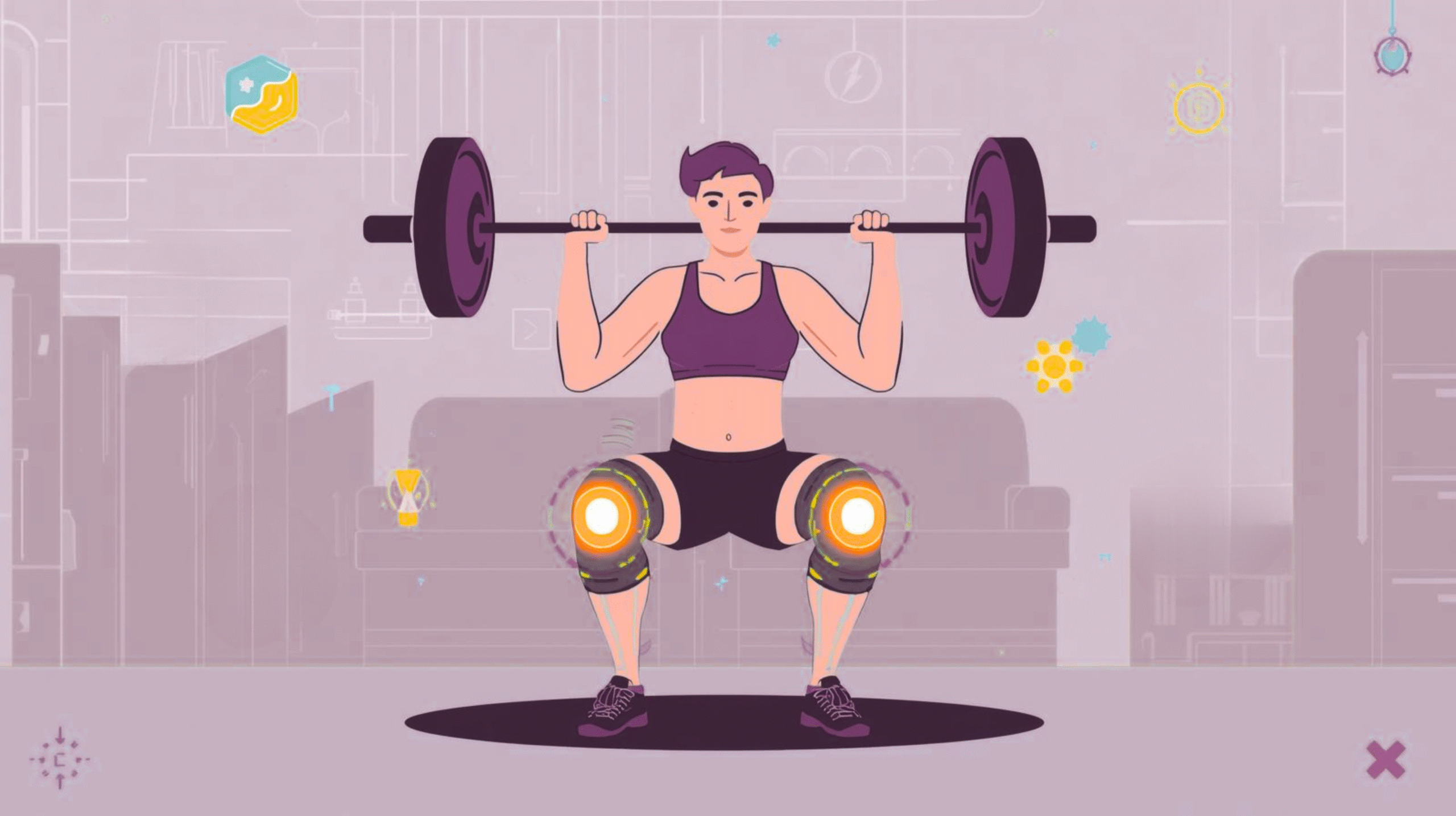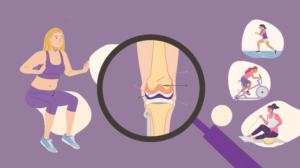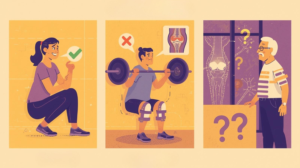Weightlifting places substantial emphasis stress on the knees, particularly during exercises that involve deep flexion, heavy loads or explosive movements. Squats, jerks and deadlifts generate significant compressive and shear forces across the knee joint, challenging its structural integrity and demanding precise muscular control and stability. The knees depend on the coordinated function of quadriceps, hamstrings, glutes and supporting ligaments to absorb these loads safely. Without proper technique and conditioning athletes rick acute injuries such as ligament tears, meniscus damage or chronic conditions like patellar tendinopathy and joint degeneration.
To mitigate these risks, many athletes and recreational lifters turn to knee supports, including sleeves, wraps, and braces [1]. These tools aim to enhance proprioception, provide compressive support, reduce discomfort, and sometimes improve lifting performance by stabilizing the joint. However, the benefits of knee supports are maximized only when they are used correctly and integrated with a comprehensive training and rehabilitation strategy. Ill-fitting or improperly timed use may offer minimal protection or even hinder natural joint mechanics.
Scientific research and practical experience emphasize that knee support should never replace proper technique, progressive loading, or muscular development. Instead, it should complement these factors, offering both mechanical assistance and neuromuscular feedback. When applied according to evidence-based protocols, considering factors such as fit, material, compression level, and timing during lifts, knee supports can reduce injury risk, enhance stability, and allow for sustained progression in training.
This article explores the latest evidence-backed approaches to knee support in weightlifting, detailing proper application, biomechanical advantages, limitations, and integration with strength programs. By following these guidelines, lifters can safely optimize performance, maintain joint health, and confidently advance in their strength training goals while minimizing the risk of knee-related setbacks.
Understanding Knee Support Types and Their Functions
Compression Knee Sleeves
- Typically 5mm or 7mm neoprene material.
- Provide warmth, mild compression, proprioceptive feedback.
- Enhance circulation, reduce joint swelling.
- Support kneecap alignment and lateral stability.
- Often used during both dynamic Olympic lifts and strength training.
Knee Wraps
- Elastic fabric strips tightly wrapped around the knee joint.
- Provide maximal joint compression, restrict unwanted movement.
- Store and release elastic energy during the squat’s descent and ascent phases.
- Primarily for high-load, low-rep powerlifting squats, offering performance boosts.
- Require careful wrapping technique and professional guidance to avoid over-tightening [2].
Hinged/Rigid Braces
- Less common in competitive lifting; more for injury rehab.
- Provide external mechanical stabilization for ligament injuries or post-surgery protection.
- Limit knee range of motion.
Comparison of Knee Sleeves vs. Knee Wraps vs. Knee Braces
| Feature | Knee Sleeves | Knee Wrap | Knee Braces |
| Material | Neoprene material | Elastic, stretchy fabric | Hard plastic, metal straps |
| Compression | Moderate | Variable (tightness adjustable) | High (often immobilizing) |
| Support Level | Mild to moderate | Mild to high (during lift) | Maximum |
| Use | Warmth, swelling control, stability | Heavy lifting (powerlifting), maximum lifts | Significant injury recovery, instability |
| Application | Slides on easily, worn throughout | Wrapped before heavy sets, removed after | Usually prescribed, worn as needed |
| Mobility | High (fully allows knee movement) | High–moderate (may limit flexion) | Low (restricts movement for healing) |
| Best For | General support and prevention | Short-term support for powerlifts | Post-injury, ligament tears, surgeries |
| Comfort | Comfortable for longer time | Can feel tight/uncomfortable, if overused | Least comfortable, bulky |
| Requires Guidance | No, simple to use | Yes, requires learning proper wrapping technique | Yes, must be fitted and used as prescribed |
| Drawbacks | Not for major injuries | Can cause circulation issues if too tight | Limits training options, not for healthy knees |
Scientific Evidence Supporting Knee Supports for Weightlifting
Research shows knee sleeves and wraps can provide functional improvements through several mechanisms:
- Proprioceptive enhancement: Studies report improved joint position sense and balance with sleeves.
- Joint stability: Compression and material stiffness increase kneecap tracking and reduce valgus/varus deviations.
- Pain modulation: Warmth and compression aid symptomatic relief in mild knee irritation.
- Performance gains: Knee wraps improve mechanical output and peak power during squats by storing elastic energy.
These benefits underscore why protocol-based use is essential to maximize safety and performance benefits while mitigating risks.
When to Use Knee Supports?
Start Without Supports
- Focus on technique mastery, mobility, and foundational strength first.
- Avoid supports during initial learning to develop natural stabilization.
Introduce Sleeves in Moderate to Heavy Lifts
- Use 5mm sleeves as intensity approaches 70–80% 1RM for dynamic lifts.
- Use 7mm sleeves for heavy squats (>80% 1RM) or during periods of knee discomfort [3].
- Apply sleeves during working sets; remove during warm-ups or recovery sets.
Reserve Wraps for Maximal Loads and Competition
- Knee wraps should be introduced under coach or physiotherapist supervision.
- Use wraps during heavy, low-rep work (singles, doubles) primarily in squats.
- Avoid wrap use during warm-ups to maintain strength development.
- Apply carefully with graded tension to avoid circulation issues and muscle inhibition.
Avoid Knee Supports During Long-duration Wear
- Limit use during training to high-intensity sessions.
- Remove supports after the session to prevent dependency and muscle weakening.
Proper Fitting and Wearing Protocols
- Measure circumference above and below the knee for sleeve sizing.
- Sleeves should fit snugly without cutting off circulation or causing discomfort.
- Wrap length and tension calibrated through trial under supervision.
- Ensure that sleeves cover the entire kneecap and surrounding tissues.
- Wraps should be applied over a soft surface or sleeve to reduce abrasions.
- Inspect skin regularly for irritation during and after use.
Integration with Training and Rehabilitation
- Combine supports with progressive resistance training focusing on quadriceps, hamstrings, hip abductors, and core.
- Prioritize joint mobility work and neuromuscular control exercises.
- Use supports as a supplement, not substitute, for rehabilitation protocols following injury.
- Consult healthcare or sports medicine professionals when pain or instability persists.
Risks and Limitations of Knee Supports
- Muscle weakness from over-reliance: Use protocols strongly discourage daily or constant use.
- Improper wrapping can cause vascular compromise or nerve irritation.
- Supports do not prevent all injuries: Proper form and training progression remain paramount [4].
- Not suitable for serious structural damage: Medical intervention required beyond support.
Who Can Benefit from Knee Supports?
- Intermediate and advanced lifters training near maximal intensities.
- Powerlifters and Olympic weightlifters competing or peaking.
- Athletes recovering from minor ligament or tendon irritation.
- CrossFit competitors and strongmen using explosive lower-body lifts.
- Recreational lifters with occasional knee discomfort seeking joint support.
Protocols for Preventing Knee Injury
An effective knee injury prevention program emphasizes maximizing strength, flexibility, and control of the muscles surrounding the knee. Important components of the program include:
- Warm-Up: Properly preparing the body for physical activity can help decrease strains and tears.
- Strength Training: Strengthening the muscles surrounding the knee (i.e., the quadriceps, hamstrings, and glutes) provides additional stability and support.
- Balance and Coordination: Improving balance will decrease falls or awkward movement patterns that may lead to an injury.
- Flexibility: Stretching to improve flexibility of your legs and hips will support a good range of motion, decrease does stiffness, and decrease the risk of injury.
- Agility Drills: Drills that promote your ability to change directions quickly and safely will help protect your knees during sports and everyday activities.
- Jump and Land Techniques: Learning how to jump and land correctly decreases knee impact and injury patterns.
- Decrease Your Intensity: Gradually decreasing the intensity of your activity followed by a stretch, allows your muscles to return to a state of recovery without injury.
Final Thoughts
In conclusion, knee supports can be highly valuable tools for weightlifters when used correctly and in alignment with scientifically validated protocols. By providing additional joint stability, these supports help athletes maintain proper alignment during heavy lifts, reduce strain on ligaments, and enhance overall confidence when performing demanding exercises such as squats or deadlifts. Beyond physical stabilization, knee supports can also play a psychological role, allowing lifters to push closer to their limits with a sense of security. However, their benefits are maximized only when combined with proper lifting technique, progressive strength conditioning, and structured recovery strategies. Misuse or overreliance can increase the risk of injury or create dependency. Therefore, following evidence-based guidelines ensures that knee supports serve as an effective complement to training rather than a substitute for foundational strength. When integrated thoughtfully, they can contribute meaningfully to both short-term performance gains and long-term joint health.
Frequently Asked Questions:
1. Can I wear knee sleeves for all my lifts?
Knee sleeves are best for heavy, knee-intensive lifts like squats and cleans, typically above 70–80% of your max. They’re unnecessary for warm-ups or light lifts.
2. How tight should knee wraps be for squats?
Wraps should be snug enough to support but not so tight they restrict circulation or cause pain. Proper technique and gradual tightening ensure safety and effectiveness.
3. Should beginners use knee supports?
No, beginners should focus on mastering form and building strength without support. Introduce sleeves or wraps only as loads increase.
4. How often should I replace knee supports?
Replace knee sleeves every 1–2 years or when they lose elasticity or fit. Wraps should be replaced when worn or stretched out.
5. Can knee supports prevent injuries entirely?
No. Supports reduce injury risk and improve stability but cannot replace proper technique, strength training, and recovery.
References
- Sharif NAM et al., “Biomechanical and functional efficacy of knee sleeves,” Clinical Biomechanics, 2017, https://pubmed.ncbi.nlm.nih.gov/28673759/
- Callaghan MJ et al., “The Effect of Knee Braces on Quadriceps Strength,” Journal of Orthopaedic & Sports Physical Therapy, 2016, https://www.jospt.org/doi/10.2519/jospt.2016.5093
- Lake JP et al., “Wearing knee wraps affects mechanical output in back squat,” J Strength Conditioning Research, 2012, https://pubmed.ncbi.nlm.nih.gov/22995993/
- Gymreapers, “Benefits of Knee Sleeves for Lifting (According to Science),” 2023, https://www.gymreapers.com/blogs/news/knee-sleeve-benefits























